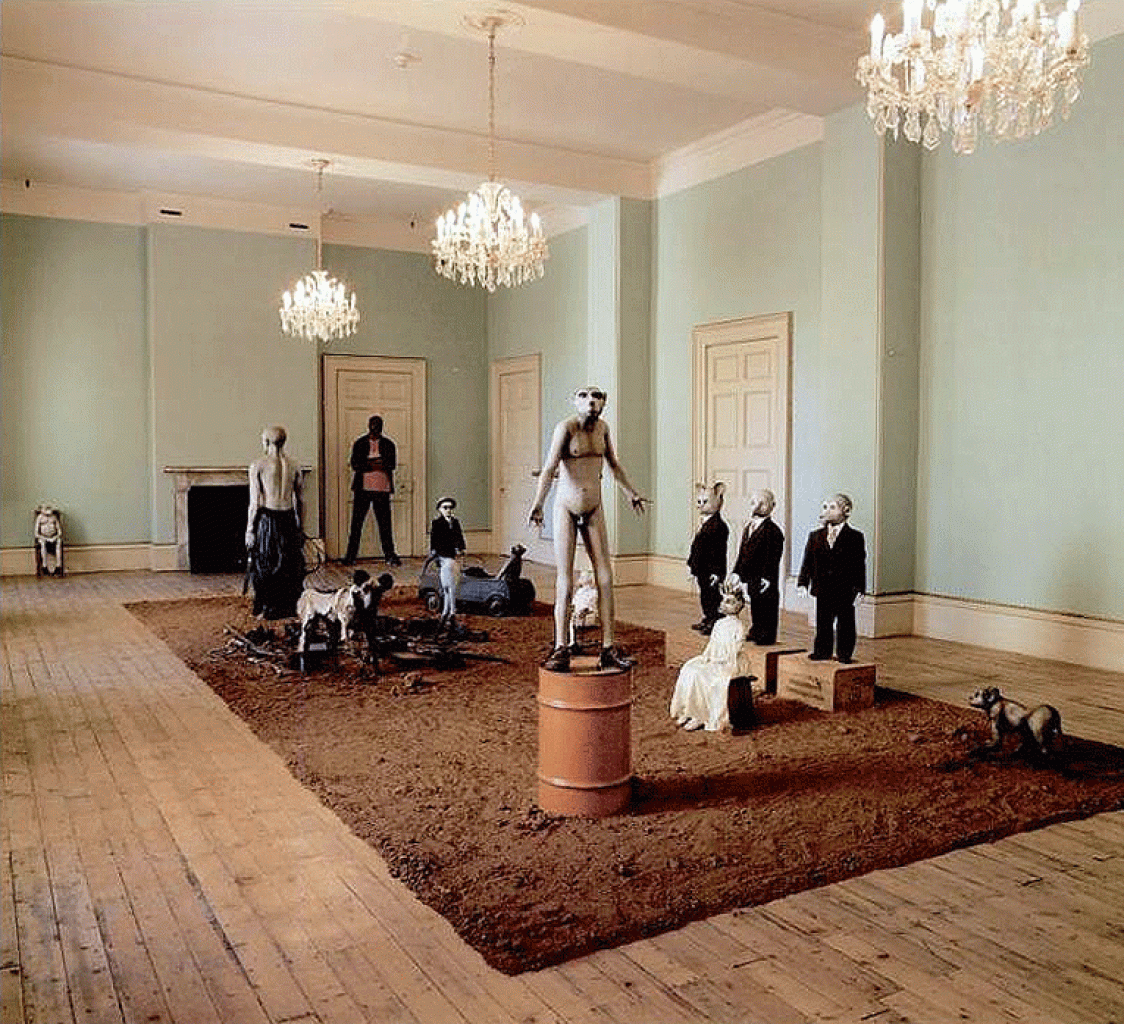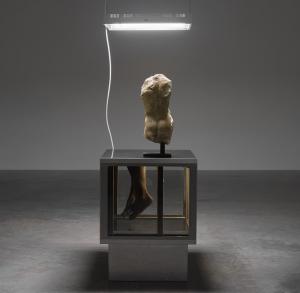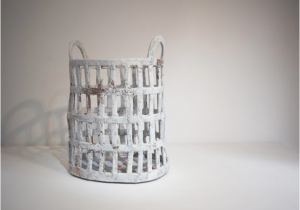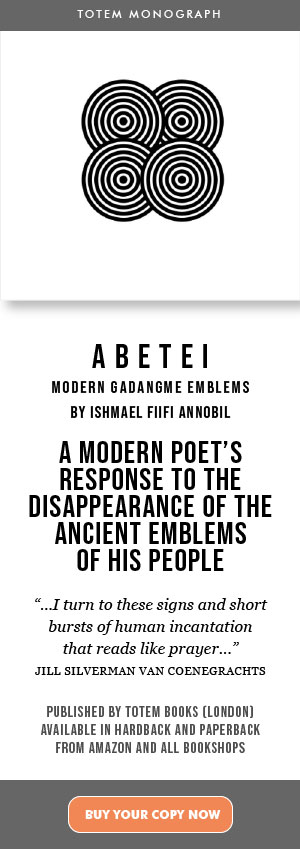AFRICA REMIX: THE CANDOUR OF SURROGATES
Hayward Gallery, London
10 Febr. - 17 April 2005
Reviewed by Ishmael Annobil
Ever since Benin sculpture rose from under looters’ beds to dominate the fine art discourse, international artists have seemed prone to reinvent the wheel, to surpass that redoubtable African ‘thing’. This may be because the Benin paradigm came to the West by way of social extrusion only, and not by open, honest display and acceptance of its philosophical and aesthetic status as a first spark. It also had a mountain to climb in order to shed its begrudging labels: carvings, fetish figures, curios, handicraft, etc.
That is not to say there hadn’t been earlier antecedents in Africa. Only, those earlier gems are of a totally different ilk – though they are universally otherworldly to the eye, they are populist in essence, and thus easily transportable into a nebulous geographical zone, in the name of common human ancestry. I speak of ancient Egyptian art (treasure) and its present 'Mid-Eastern' rather than African location.
Of course, Sudan’s gallery of pyramids is totally ignored. It is not convenient for this palimpsest geography; it would point to an African authorship. Nor can we conceive of adding 'Sudanology' to the faculty of ancient studies. Alas, the meticulous revisionists have similarly inclined allies in today’s Arab custodians of Egyptology, whose recent entry into Egyptian history (circa 766 AD) makes them equally envious of the glorious past. Their so-called, foremost archaeologist was recently reported as saying that the ancient Egyptians were not of this realm ( from outer space?, I wonder). The fever obviously got to him.
But hallowed or not, those grand edifices to the incestuous megalomania of pharaohs are not really it. The true Egyptian art icons are often on a smaller scale, and sadly wrapped in cotton wool, in vaults, as though they were not legitimate forebears. The grander, more populist ones on display to the world may show some occasions of symbolic extension, incidents of animatism, and even mythological hybridism, but modern art does not really feel their punch. Neither are they truly inspired, as they mostly depict the mindset of a people forced to interface with some overweening, celestial essence of a bunch of inbred god-kings. Sycophancy.
Any modern artistic interpretation or emulation of this pristine grandeur is therefore bound to be tacky. It’s more the fodder of ‘astro-artists’ and new age shamans, in whom it causes a tendency towards cheesy ultra-realism. Dream psychosis. This is because it actually lacks the necessary corporeal and spiritual balance. It is not in touch enough with humanity to be even idealised further or abstracted or deconstructed. It is, of course, very beautiful, but also very rigorous and lacking in spontaneity and, therefore, staid in real artistic terms – too much awe and no grit. Nazi. It doesn’t work.
Admittedly, the purpose of this furious polemic is to redirect modernists to the true African art masterpieces, past and present, and even the folk and religious forms. Africa is still producing challenging art. And the continent’s legion of Avant Garde artists are even very accepting of the recycling of the expressionistic idioms of their ancestors by great artists like Picasso; maybe because they recognise it as a sign of atavism, or that art is for all.
However, Africa has actually lost its way. It cannot muster the energy to curate its own artists properly. Neither does it attempt to create the requisite agency, let alone master the basic protocol of provenance. African artists today seem like a fuselage of lost souls, trawilng the ether for a destination. Once in a while a surrogate pennant flashes up, pointing to a landing pad beyond, and a few grateful artists suddenly enter the fraternity of international art, to unpack their treasure to an appreciative audience. Hence Africa 2005, and also the riveting Africa Remix (shame about the pop title) at Hayward the Gallery.
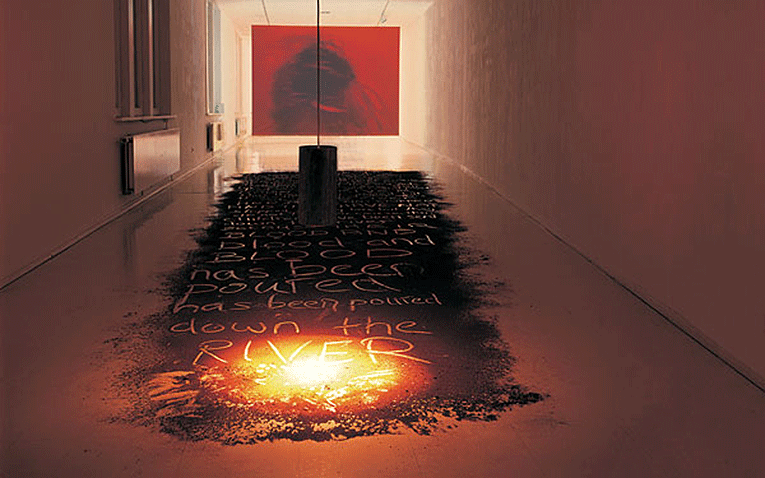
Kenyan Ingrid Mwangi's Down by the River set a haunting meditative tone with its exploration of spilt blood. This installation, which utilised Kenyan red soil and a looped projection of reddened water to symbolise the haemorrhaging, was accompanied by a mournful note: "Past and present crimes of violence blend into each other, leading to a state where pain and death are countered by hope and continuity - the water is red, though the red is a symbol of life. Ironically, the fertile earth has to absorb the blood of violence".
The mat of red soil was inscribed further with a hand traced eulogy, which was allegorical in its admonition, maybe because Down by the River was both about pain and healing: "...they have not stopped making love, but they do not love... because their children have been sent down the river..."
The accompanying projection showed a tentacled object pulsating in reddened water (the river) like a being wrapped up in eternal coitus with itself or with something other, solid and fluid. Or was it the spirit of the dead intruding on the coitus of the living mourners? Once in a while, this strange object was washed over by eddying red waters. And given the dichotomous emotions of the installation, each eddy reminded one of fresh blood; a libation to stained history. Hope then becomes but a figment of imagination, because it will be forever undermined by personal and political woe.
Well, of course. Such is today's Africa; it' no fantasy, and alongside such perniciousness runs a an equally crippling need to shatter the dreams of the individual. For that matter, very few African artists are genuinely inclined to depict their true revulsion or even dissent, however cryptic their narrative powers. They can only hope to do so successfully in exile. Mwangi is a Kenyan-born German.
Unlike her, those based in their home countries are wont to exercise their polemical marksmanship on a foreign enemy instead - the West - and attempt to undo its convoluted political medicine that frustrates the Diaspora and the Third World with its unbending preconceptions, fears and greed. Belgium based Burundian Aimé Ntakiyica's photo tableau, WIR 2003, depicting an African man in various European guises, Scotsman, Bavarian and Spanish Matador, told of the forcible routes to assimilation adopted by those Africans in Diaspora who have lost faith in their own cultures. It was rather jocular in pose, almost jeering such prodigals, perhaps for their exaggerated affectations, and yet it also reflected a racial forlornness and the need to blend in and not create waves. Mental bondage.
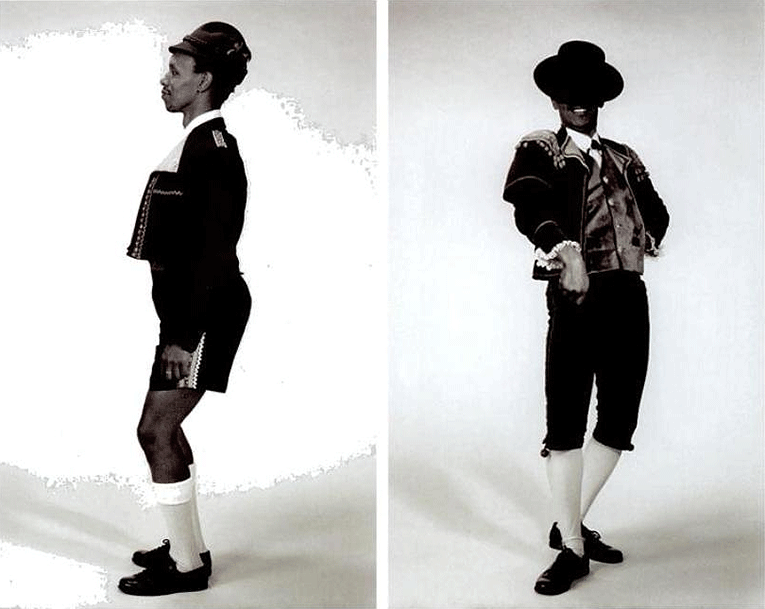
But South Africa changes the trend somewhat. Its newly won democracy offers its home-based artists the freedom to express angst through rhetorically rich work, which is at once locus-specific, while also representing the unseen African artists who are stymied by fear in their own countries. Jane Alexander's trauma-scape, African Adventure, showcased the various personifications of post-Apartheid South Africa, each mythic being acutely expressing an aspect of a grand debacle, precipitated by both the mania preceding the status quo and the innervated consciousness and myopia of the new leaders.
Alexander's subjects are anthropomorphic sculptures, each with an air of grand solemnity and momentousness, whatever its role. The Harbinger stands on a red barrel with his back to the folk (see top photo), presumably anticipating hope. Its hybridism adds to its aura of prophesy, while its subtly beseeching right hand seems to question the abandonment of its folk. Meanwhile, the diminutive Custodian sits on a parrot stand, looking rather jaded, observing the three Radiance of Hope figures standing on boxes of explosives behind a fingerless bride on a stool. Behind the custodian a settler in car is edging slightly across the path of a hooded colossus, Pangaman (or machete-man), who is dragging his burden (or loot) of machetes, tractors and sickles into his own horizon, followed attentively by a stork who seems poised as if to scavenge any stray loot.
The heady juxtaposition of Pangaman's accoutrements establishes an instant preference for the countryside, where the defeated former rulers huddle up and expect to die. Pangaman's agricultural and land ownership aspirations seem thwarted, and therefore easily recyclable for murder. He is oblivious to the political dialogue and alchemy that rumbles over his head. In any case, a wild dog, partly disguised in the coat of another animal, is making its way back from the same horizon he heads for. It has made its kill and is now partly tuned into the harbinger's meditation. Jane Alexander's narrative elevated the entire Africa Remix with its huge contemplativeness, psychologism, 'psychorealism' and dream-like exactitude.
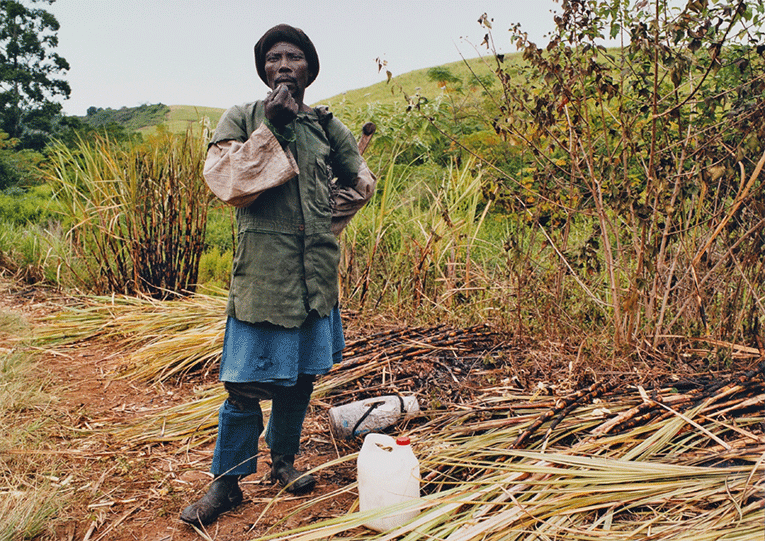
Fellow South Africans, Zwelethu Mthethwa and Guy Tillim fine-tuned this sad narrative with their photographic studies of the rural and urban worker-classes and the poor. Mthethwa's subjects' unapologetic stares were often gleaned from their grim vocational settings that nestled contrapuntally amidst idyllic landscapes, while Tillim's stark portraits depicted the true face of crippling poverty and hopelessness within the palpably implosive fringe environment of shanty-town.
Africa Remix also provided edgy political comedy, what with Sudanese Hassan Musa's shocking psychological truism, Great American Nude: a naked Osama Bin Laden fully compromised in bed, sporting the backside of a classical artist's female model, ensconced in a realm of Americana; except, the American flag is spangled with Harley Davidsons. Yet he is lying the wrong way round on the bed; his cocked right foot rests on the pillow as though to make it unwelcoming - he is only teasing, after all; he wants the whole bed to himself. The piece illustrates a Freudian notion of inverted infatuation, both on the part of the hunter and the hunted. Also in that vein is Abu Bakarr Mansaray's set of technological allegories, characterised by labeled parts: superguns, a Mobile Telephone Discovered in Hell, and Turbo Charge, which is the only thing left standing on the planet after the total annihilation of humankind, and supercharged by a giant phallus, labeled: "Capable of paralysing all wild animals. No limit."

Then we enter the zone of nebulousness. Yinka Shonibare, known for his exploration of what he calls his mixed identity (British and Nigerian) presented an installation depicting the same, visually speaking: Victorian Philanthropist's Parlour. Here the walls and furniture are clad in West African Hollandaise fabric, except for a white marble bust of a European man, which gives away the identity of the occupant. As with most of this fine artist's concepts, one wonders about the truthfulness of the identity crisis. Is it rather a hankering after the otherside, as in the case of the subject of Aimé Ntakiyica's tableau, or is it an attempt to revise of the subjugation of Africa by the European, or is it both things? Exorcism.
Despite the avowals of Post-colonial 'hybridism', each of his pieces only manages to delineate the ambitions of the well-heeled and those of the wannabe, causing the keen viewer to suspect something less than the intended subversion of contemporary perception: more an aim to rewrite history itself. After all, Shonibare is obviously of wholly African parentage. That said, all of his works show an acute sense of dateline, sartorial acuity and incredible finesse.
Africa Remix was a triumph. Above all, it updates the status of the ancient looter as that of a kindly, discerning surrogate. However, the Diaspora aspect seemed to have merely applied to recent arrivals. Extra contingents from West Indies and Americas would have certainly sent the whole thing sky high with their natural irony/angst balance, mastered after their many years of Christian fortitude, Christian invisibility, and the long socio-political struggles.
But, one must really address that shortfall to the African continent. The next venue must be in Africa, and it must include non African artists, too. The whole culture-centricity may have its academic and political ends, but inclusiveness on the basis of vocation and merit is ultimately more viable, philosophically speaking.
Image Credits:
Jane Alexander, African Adventure
Ingrid Mwangi, Down by the River
Aimé Ntakiyica: WIR 2003
Zwelethu Mthethwa, Untitled, from the series Sugar Cane, 2003
Hassan Musa, Great American Nude, 2002, Ink on textile


